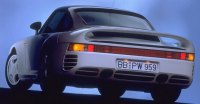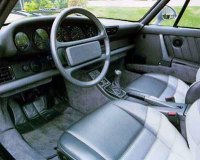 959
had two versions: 959 Comfortable and 959 Sports. The Sport version had
the same power, but weighed 100 kg less than the Comfortable version so
as to provide even higher performance, especially were handling and acceleration.
What diet did it go? Firstly, the variable ride height and damping was
discarded. Then, all the luxury items were deleted - air-conditioning,
power windows, central lock, the useless rear seats and even passenger
side mirror. The electric leather seats were replaced by manually-adjusted
sports seats.
959
had two versions: 959 Comfortable and 959 Sports. The Sport version had
the same power, but weighed 100 kg less than the Comfortable version so
as to provide even higher performance, especially were handling and acceleration.
What diet did it go? Firstly, the variable ride height and damping was
discarded. Then, all the luxury items were deleted - air-conditioning,
power windows, central lock, the useless rear seats and even passenger
side mirror. The electric leather seats were replaced by manually-adjusted
sports seats.
As the ride height adjustment had gone, the Sports version used stiffer springs and dampers.
I cannot find any 959 website explain why Porsche had to create these two derivatives, but in Paul Frere's book "Porsche 911 Story" I found the true answer:
"Whatever care is taken to save weight, a car carrying such an amount of advanced technology cannot be a lightweight. Originally, Porsche predicted a weight of 1,450 kg with full tanks, but this eventually turned out to be optimistic by anything between 150 and 200 kg ...." No wonder Porsche had to make a lighter version.
However, even the lighter Sports version tipped the scales at 1,566 kg with a full tank of fuel when it was tested by German magazine Auto, Motor und Sport. This corresponds to about 1,530 kg kerb weight (half tank of fuel), very different from the factory figure of 1,350 kg. Obviously 959 was overweight by any standard.
Few customers felt inclined to sacrifice those luxurious items to even higher performance, so only 6 Sports version were ordered.
